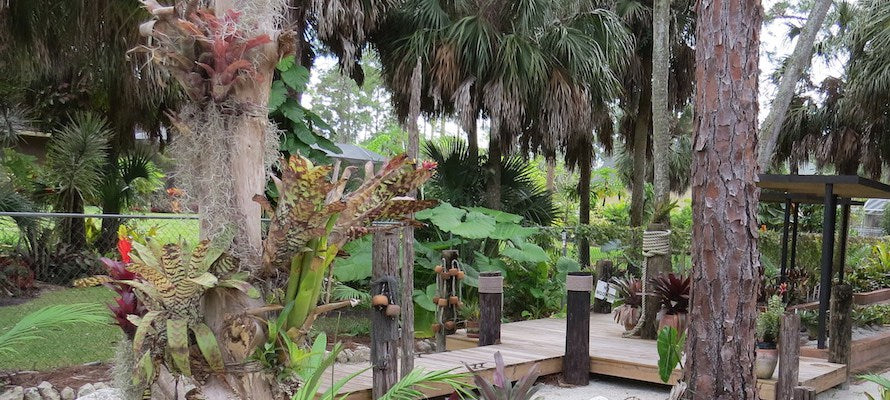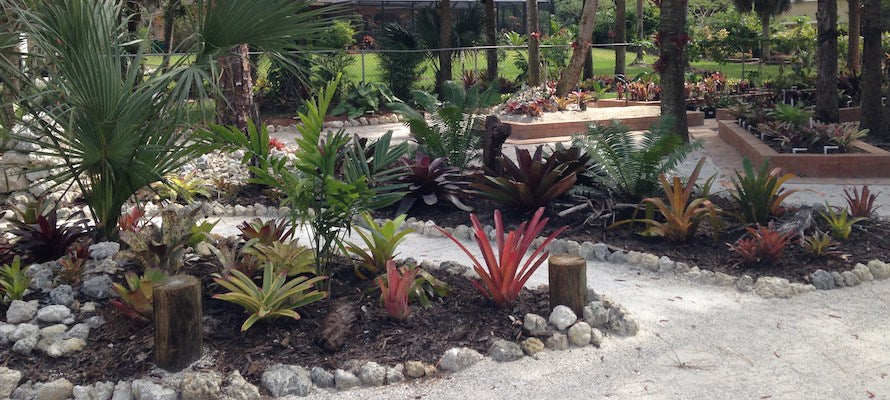Your Cart is Empty
Get Free Shipping on all orders $120 or more.

Bromeliads consist of a large family of plants native to temperate North, Central and South America. These plants are quite unique in the fact that they can be found growing in numerous habitat types such as forests, savanna's or even the desert. They can be found growing on trees, on scrub, on rocks or in the soil. This amazing life process gives these plants the ability to adapt to a wide range of environmental conditions. However, if the grower has a general understanding of the needs of individual species or hybrids and applies them right, a plant can reach its full potential of size, form, color and general appearance. This can be done by doing a little research on the individual plant or contacting your seller for more information.
Fertilization is one of the key success factors in caring for your bromeliads.
Bromeliads are generally slow growing plants that do not need a large amount of fertilizer. The best method seems to be to use slow, time-release fertilizers lightly sprinkled around the base of the plant. Never place fertilizer grains directly in the cup of tank bromeliads, doing this will risk burning the foliage and might foster the growth of algae or invite rot. Liquid fertilizer is another method, especially for air plants that cannot be fertilized any other way. Use 1/2 to 1/4 of the recommended strength and spray several times per season. Flush tank bromeliads out with water occasionally to prevent the buildup of salts and or algae that may damage leaves.
Some bromeliads, particularly Guzmanias and Vrieseas, can be “pushed” to grow quicker by adding extra fertilizer. Most, though, will not benefit by excessive fertilizer which will tend to make the plants “leggy” (excessively long leaves) or, in the case of those with colorful foliage, like Neoregelias, it will diminish the colors turning the plant green.
If you’re plant is being repotted, mix slow-release fertilizer pellets into the potting mix or add a layer of pellets in the bottom of a quarter filled pot. Adding the pellets to the bottom has the advantage of releasing the fertilizer where the roots are going to naturally want to grow. Though bromeliads are naturally epiphytes, they can be trained to feed through their roots. A healthy root system is always the basis for a healthy bromeliad. Don’t put any kind of solid fertilizer (powder or pellets) directly into the central cup. This will burn the plant
If you’re plant is well-rooted, with healthy, extensive roots, you can top-dress the soil with slow-release pellets at the beginning of the growing season. Be aware though that too much fertilizer can either burn the roots or overstimulate leaf growth turning your plant into a droopy green
You can also use a weak liquid fertilizer during the growing season. Avoid high nitrogen fertilizers as these will likely hurt the plant’s ability to flower (unless you’re aiming for nice foliage). Mix the fertilizer at 1/4 of the label strength and apply with a spray bottle. Be sure to only fertilize during the active growing period; fertilizing a dormant plant can burn the leaves.
Within these broad guidelines, it’s important to remember that the different bromeliads have somewhat different requirements. After all, each of these species have adapted to living in a different environment, and your goal with each species might be different (you might want large flowers in one species, for instance). Follow these guidelines from the Bromeliad Society International for the individual species:
Aechmea: Feed monthly during the growing season with a top dressing of 14/14/14 time release fertilizer.
Billbergia: Feed monthly during the growing season with a top dressing of 14/14/14 time release fertilizer.
Neoregelia: For best leaf color, use a low-nitrogen time release fertilizer. Feed every other month during the growing season with a top dressing.
Guzmania: Feed monthly during the growing season with a top dressing of 14/14/14 time release fertilizer.
Tillandsia: Soft-leaved tillandsia types can be potted; hard-leaved types should be mounted. Spray hard-leaved types directly with low-nitrogen liquid fertilizer at 1/4 strength; soak occasionally. Treat soft-leaved types like neoregelia.
Top Dressing
5″ std. round pot 6″ std. round pot 8″ std. round pot 10″ std. round pot
1 teaspoon 1 teaspoon 1 tablespoon 1 tablespoon
The post Bromeliad Care: Fertilizer appeared first on Bromeliad Paradise.

When a bromeliad is ordered on-line, it will either be taken as an offset from a mother plant, or it will be taken from a pot. Either way, it is possible that it has already started to grow roots.

Bromeliads are a type of plant called epiphytes, which means that they draw moisture from the air and don’t need to be in soil to survive. While their roots can draw water and nutrients, they typically serve as a plant’s ‘anchor’, attaching and holding it place.

Although mosquitoes are not a pest that can harm your bromeliads, they can become very annoying to everyone around them. Mosquitoes are currently a topic of conversation as common sense and the facts often give way to rumor and sensationalism.